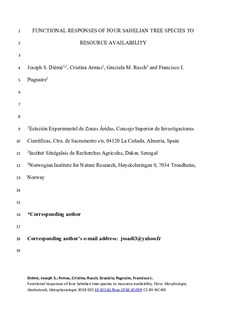| dc.description.abstract | Plants experience a fluctuating environment in time and space that affects resource supply. As human impacts on the environment directly and indirectly alter resource availability, it is important to address plant responses to changing resources to be able to anticipate impacts of these changes on plant communities. We analyzed plant traits to assess responses to resource limitation in four Sahelian tree species of wide ecological and socio-economic importance. We used species already adapted to harsh conditions (high temperatures, low rainfall) to anticipate how climate change could affect their growth patterns and, indirectly, their spatial distribution and the services they provide. Seedlings grew under two levels of water and nutrient additions in a factorial design. Our results showed differences among species, watering regimes, and nutrient supply in three key functional traits related to the plant’s resource-use strategy, relative growth rate (RGR), root-to-shoot ratio (R/S), and specific leaf area (SLA). On average, RGR was responsive to the amount of water and nutrients, with species with high RGR showing the largest response to resource supply. RGR in the species with a conservative resource-use strategy (evergreen leaves, lowest RGR) remained unchanged with different levels of water and nutrients. Overall, large RGR was supported by large SLA. All species allocated more biomass to roots than to shoots, particularly under low resource supply, reflecting adaptive strategies to keep RGR leveled to resource supply. Not all species showed similar plasticity in their functional traits responses; however, Acacia tortilis and Faidherbia albida showed the greatest plasticity, which may explain their large geographical distribution range in Africa. Our data suggest that the different Sahelian species will respond differently to future environmental changes, likely affecting their geographical distribution, the structure of plant communities, and the services they provide. | nb_NO |

